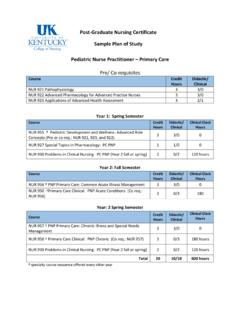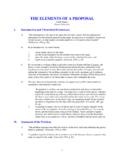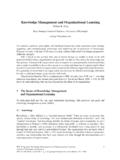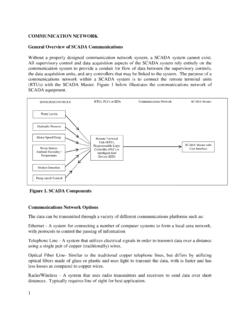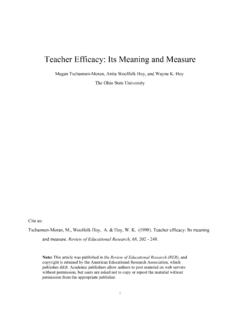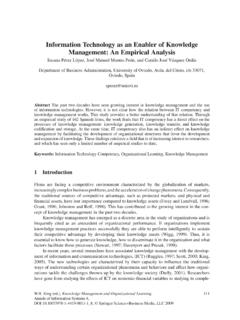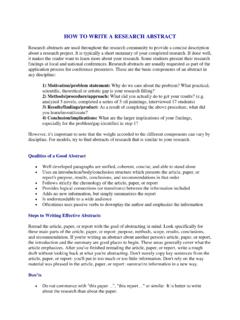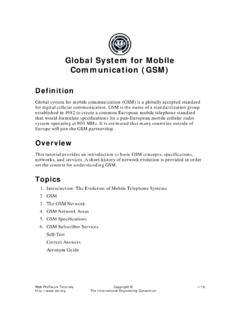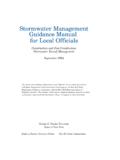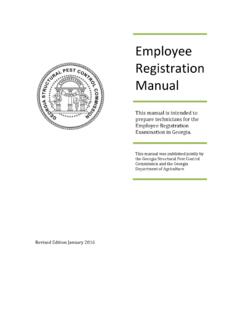Transcription of Training Manual for Right-of-Way Vegetation …
1 AG R I CU LTU R E HOME ECONOMICS 4-H DEVELOPMENTC O O P E R A T I V E E X T E N S I O N S E R V I C EU N I V E R S I T Y O F K E N T U C K Y C O L L E G E O F A G R I C U L T U R EPAT-1-6 Training Manual for Right-of-WayVegetation ManagementContentsPageIntroduction .. 2 Goals .. 2 Planning Requirements .. 2 Topography .. 3 Biology and Ecology of Weeds .. 4 Vegetation and Management Control Methods .. 6 Classification of Herbicides .. 7 Herbicide Application Methods and Equipment .. 8 Soil Factors that Influence Herbicides .. 9 Environmental Factors that Influence Herbicides .. 9 Public Relations Concerns .. 11 Environmental Concerns .. 11 Laws, Regulations and Guidelines .. 11 Calculating Rates.
2 13 Glossary .. 14 PrefaceThis publication was prepared by a committee of specialists in the University of Kentucky Cooperative ExtensionService, personnel in the Vegetation Management Association of Kentucky and members of the Division of Pesticidesof the Kentucky Department of Agriculture. When used in conjunction with the EPA Core Manual , Applying PesticidesCorrectly, this Manual will provide information to meet minimum EPA standards for certification of commercialapplicators in Category 6, Right-of-Way Pest Control. Additional helpful information for Right-of-Way applicatorsmay be obtained from the Cooperative Extension Service, regulatory agencies, pesticide labeling, pesticide dealersand industry representatives, and utility rights-of-way company personnel involved in Vegetation following persons contributed to this Training Green, Extension Weed Hartman, Extension Plant Johnson, Extension Primus and Spatcher, Du Pont Wheeler, Jr.
3 , Louisville Gas and Electric are the areas involved in common are essential for the proper functioning of a modernsociety and include: federal, state, county and township highways and roads, public airports, railroads, electric utilities (including substations, switchingstations, transmission lines and distribution lines) pipelines (including pumping stations), public surface drainageways, public irrigation waterways, banks of public bargeways and areas around locks anddams, bicycle, bridle and other public paths or trails (outsideestablished recreational areas).Rights-of-way may be found everywhere and areplaced in every type of terrain, soil, climate, Vegetation complexand land-use area.
4 Vegetation management on rights-of-way isdesirable and necessary for a number of reasons, both aestheticand practical, including: safety due to improved visibility on transportation rights-of-way, reduced fire hazard by the encouragement of less fire-prone plants, soil erosion control, assured continuity of utility services, promotion of the health and comfort of the public, ornamental values enhanced by control of In addition, maintaining land in an early stage of plantcommunity succession often encourages the growth ofpersistent vines such as kudzu which can be as undesirable aslarge woody plants. The type of Vegetation managementnecessary will depend on the function of the Right-of-Way , aswell as its topography, biology and ecology.
5 Of paramountconsideration is the type of Vegetation Vegetation includes those plants that: create a safety hazard or nuisance, impede the normal operation or functional activities of theright-of-way, are considered noxious, repress desirable Vegetation , cause damage to rights-of-way structures, such as roadsurfaces, railroad ballast, utility wire poles or supports, andpipelines and pumping stations, provide harborage for undesirable wildlife, constitute a detriment to crops and cropland if allowed management is necessary and in most casesdesirable; but since most rights-of-way are long and narrow, theyoften touch the property of many landowners. Neighbor conflictsmay become magnified especially if Vegetation managementefforts are not contained within rights-of-way relations problems between rights-of-way users andtheir neighbors are minimized when the public is informed ofthe Vegetation management needs and methods and whenvegetation management personnel know and execute a programwith definite goals and principal goal of Vegetation management is to ensurethe protection, operation, stability, continuance and safety of thecommon transport involved.
6 Other goals of a well-plannedvegetation management program may be to: naturalize the Right-of-Way using indigenous plants,where possible, to make the Right-of-Way blend in with thesurrounding landscape, reduce maintenance costs, reduce erosion or water quality problems, provide feed or shelter for RequirementsSuccessful Right-of-Way Vegetation management requiresgood planning which incorporates stated goals and objectivesinto a rational, comprehensive and practical program. Thisplanning must include recognition of the environmentalrequirements of desirable plants and the incorporation ofmethods that will accomplish the goals and objectives in themost economical, environmentally sound and practical properly planned and executed Vegetation managementprogram will use a variety of Vegetation control techniques andstrategies that will be dictated by economics, terrain, vegetationtype and public relations.
7 The program should have options forTraining Manual For Right-of-Way Vegetation ManagementFigure 1. Railroad Right-of-WayRights-of-way generally must be kept free of large brush ortrees that is, maintained in an early stage of plant communitysuccession which means that Vegetation must be continually3alternative management methods, such as cropping and grazing,as well as chemical weed and brush control. Good planning andexecution can result in: increased public acceptance of the Right-of-Way facility, fewer complaints about the Right-of-Way , reduced maintenance cost, decreased damage to facilities and structures, fewer operational interruptions, increased safety, improved public relations and less legal difficulty withpublic action groups and Right-of-Way neighbors, reduced erosion and water pollution, improved cost planning and control, better utilization of equipment and reduced work are basically composed of a series of narrowstrips of land that are used for different types of commontransport.
8 For example, electric utility rights-of-way vary inwidth from 30 feet to 200 feet and have been set aside for theerection of poles and guys, towers and electrical conductorsnecessary for carrying electrical current to utilization points that is, from the point of electrical generation to the individualcustomer s premises. The electric company usually acquiresthese rights-of-way from property owners through an easementwhich grants the utility company the right to install and maintainthe facilities necessary for the transmission and distribution ofelectrical current. The utility company does not normallypurchase the land for the rights-of-way; rather, it simplyacquires permission or easement from the property owners toinstall needed facilities.
9 In many instances, one or more types ofrights-of-way are combined. For example, a highway Right-of-Way is often built next to a utility terrain over which these rights-of-way pass is just asvaried as the material being transported. The terrain crossed willvary from farmland used for annual crops or pasture throughgently rolling hills to rugged and almost inaccessiblemountainous terrain. Rights-of-way also pass over streams,rivers, lakes, ponds and variety of Vegetation is encountered along a Right-of-Way . Areas devoid of unwanted Vegetation , such as land usedfor agricultural purposes, give way to pastures, low-growingshrubs and brush, as well as fully grown trees.
10 The level ofvegetation management necessary depends on the type of Right-of-Way and the sections within that of Vegetation ManagementHighways and railroads obviously need absolute vegeta-tion control in the roadbed. The shoulder of the road or rail lineis usually maintained free of Vegetation to facilitate remainder of the Right-of-Way may be maintained in grassor low growing shrubs. The type of Vegetation allowed to growwill be limited to those materials that do not interfere with themovement of vehicles or the vision of vehicle transmission lines through forested areas mayhave the following sections of the Right-of-Way : a central path or road for inspection and/or maintenancecrews, an area of low-growing shrubs or grasses under the wires, an area kept cleared of large trees 25 to 75 feet on eitherside of the centerline (greater clearance required for EHV), edge of easement or area off easement having dangeroustrees removed as necessary (depending on easement description).
